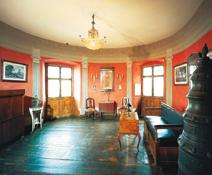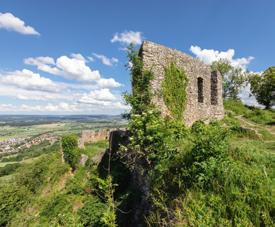
9 minute read
Taste the lake – Culinary treats
from E-BOMA 2021
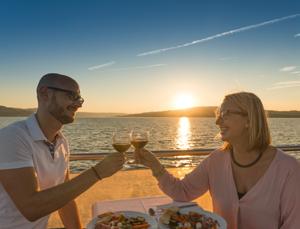
FEEL THE ELEMENTS IN WESTERN LAKE CONSTANCE Islands & volcanoes
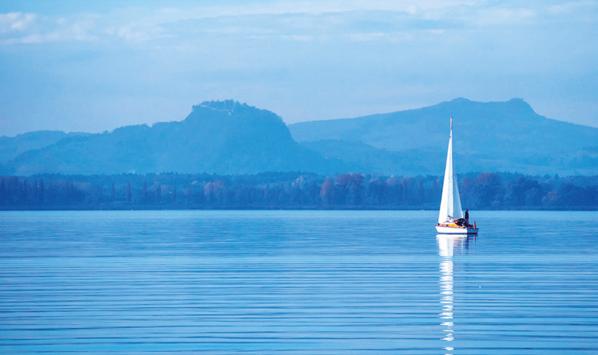
A treat for the senses
The shimmering turquoise water, wonderful lush islands and towering volcanoes put us in high spirits. Time and again, we reach into our coat pocket for our phone to capture the beauty and expanse of this landscape. But wait a minute … did you say volcanoes? Here on Lake Constance? Yes! The region’s fiery past produced a magical scenery, with picturesque islands and intact nature. This land born of ice and fire guarantees unforgettable moments.

Photo: Kristen Kohler, Mammern It may have been millions of years since Hegau’s volcanoes were active, but the magma that cooled down in the volcanic vents has withstood time and the pressures of various glacial periods. It was the latter that gave this landscape its unique character: Where the Rhine Glacier once carved out Lake Constance, formed mountain ranges and created idyllic islands in the lake, visitors seeking peace, adventure or pleasure can now find a natural paradise along the German-Swiss border.
Island hopping in the Garden of Eden
The islands at the western end of Lake Constance glisten like jewels in the blue water. They are ideal for a day spent hopping from island to island, whether by bicycle, canoe, stand-up paddleboard, solar ferry or boat. One destination is Reichenau Island, a UNESCO World Heritage Site now known for vegetable-growing. Or Mainau Island, famous for its magnificent flower displays in myriad colours, to get a whiff of royal roses. The diminutive Liebesinsel (Love Island) near Radolfzell can easily be paddled around by canoe. For hikers and cyclists, the Mettnau peninsula, Bodanrück ridge and Höri peninsula are a great experience. Of course, scheduled boats also criss-cross the lake, and the season is even extended into the late autumn on four weekends for shopping tours.
“Borderless Garden Rendezvous” event, when 79 private oases and parks are open to the public.
Photo: Achim Mende Photo: REGIO Konstanz-Bodensee-Hegau
Hohentwiel: The most famous of the Hegau’s volcanoes.
Volcano hopping to magical places
The skyline at the western end of Lake Constance is dominated by skyscrapers of a different kind. Volcanic mountains create the backdrop for sublime hiking and mountainbiking tours, just a short distance from the lake. The views from their lofty peaks, many topped with medieval castles, are fantastic. Hidden in this volcanic landscape are mysterious crater lakes, orchid forests, and the source of the River Aach, bubbling up from the depths. Hohentwiel in Singen, king of the Hegau volcanoes, is crowned by Germany’s largest fortress ruins. But not only that, the grapes of the country’s highest vineyard also ripen on the slopes of this nature reserve. Visitors can now discover how the fortress once looked in 3D, thanks to augmented reality.
Inspiration for the senses
Whether you are strolling in the shade of giant trees, unwinding in a natural garden, or chatting about old seed varieties in a cottage garden – the symbiotic relationship between nature and the gardener’s shovel has been raised to an art form in western Lake Constance. That’s hardly surprising, because this region is also the birthplace of horticulture: Abbot Walahfrid Strabo planted a monastery garden on Reichenau Island as early as the 9th century and wrote “Hortulus”, Europe’s first gardening book. The locals demonstrate their gratitude by planting the most beautiful gardens. At the “Borderless Garden Rendezvous” event, 79 private oases and parks are open to the public. A visit to the herb market in Radolfzell is also worthwhile. Here and in many other towns in the region, herb weeks are celebrated from April to June.
Photo: Stefan Arendt Boat trip on the Lower Lake: Wine and dine in style on the water.
Through the eyes of Hesse and Dix
Artists who lived on the Höri peninsular were also inspired by the picturesque shorelines of the Lower Lake and the steep volcanic hills. To see the islands and volcanoes of western Lake Constance through their eyes, just follow the art route. Where great artists like Otto Dix, Adolf Dietrich and Erich Heckel once placed their easels, iron steles now stand that frame the views the artists chose to paint and allow you to compare them with the finished picture. Influential writers also spent time on the lakeside. For example, Hermann Hesse lived on the Höri for eight years. The old farmhouse he once stayed in now houses the Hesse Museum Gaienhofen. Cyclists can follow in the footsteps of literary figures from Johann Wolfgang von Goethe to Fritz Mühlenweg along the “Pedal to Poetry” route.
Wining and dining between islands & volcanoes
At the region’s weekly and evening markets, tables sag under the weight of farmers’ vegetables, fishermen cheerfully distribute their fresh catch, and tempting aromas waft from restaurant kitchens. Thanks to the beautiful landscape, there is a wealth of activities to choose from that combine sightseeing with nature and cuisine. Examples include the “Radishes, onions and lettuce” cycle tours on the Höri peninsula, or gourmet hikes on Reichenau island. If you prefer to wine and dine in style on the water, we recommend a pleasure boat trip on the Lower Lake. Later in the year, you can combine a romantic hike with wild game specialities, when the game weeks usher in the quieter low season. And when the sun sets behind the volcanoes at the end of an eventful day, then you can really feel it – the extraordinary power of nature.
www.bodenseewest.eu
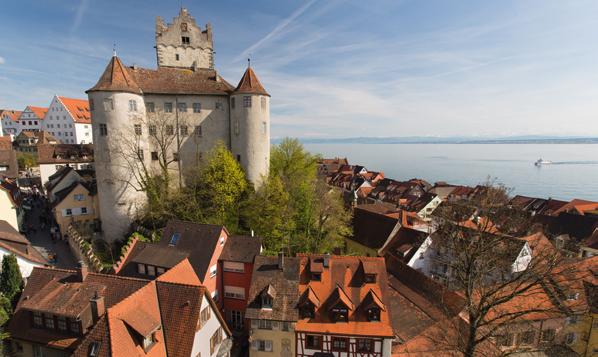
MEERSBURG More culture, more history,
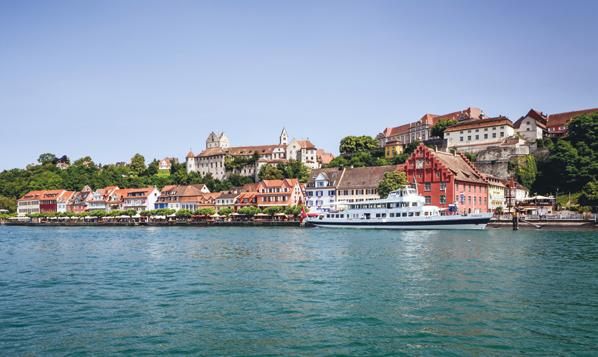
more enjoyment, more leisure
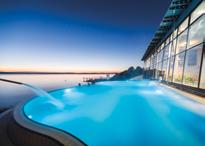
Photo: Falk von Traubenberg The romantic town of Meersburg boasts a wealth of culture and history. With its impressive setting, historic buildings, half-timbered facades and winding alleys in the old town centre, Meersburg is considered a jewel of European urban development. Meersburg Castle, Germany’s oldest occupied fortress, and the New Palace from the Baroque era dominate the skyline.


Perched high above Lake Constance, Meersburg Castle and New Palace testify to the town’s more than 1000-year history. Meersburg promises a unique blend of past and present. Located in the former Holy Spirit Hospital at the heart of the historic old town, vineum bodensee adds a fresh, modern, exceptional touch. This museum for wine, culture and history combines tradition, innovation and pleasure in an extremely inspiring way. All in all, Meersburg has much more to offer than just history and traditions. Visitors can stroll from the upper town down famous Steigstrasse to the lake and the promenade with its Mediterranean flair. They can take a seat and enjoy the culinary delights in the many different restaurants and cosy cafés or a glass of wine in one of the many wine bars. Further along the lake is Meersburg’s lido and open-air pool with Meersburg Therme spa next door. The pools and saunas at Meersburg Therme combine a swim in warm, thermal water with the chance to rest and recuperate. In the summer, holidaymakers can enjoy the water and try out various sporting activities at the lido. Positioned directly on the lakeside, it offers breathtaking panoramic views of Lake Constance and the Alps on the opposite shore. Guests can take one of the passenger boats from Meersburg to neighbouring towns in Austria, Germany and Switzerland for a fascinating day out. Residents and guests in Meersburg can choose from a wide range of cultural activities and culinary delights, with plenty of opportunities for sport or simply relaxing. Meersburg is set at the heart of an impressive cultural landscape with a well-developed network of cycling and hiking trails around the town, along the lake, and through the vineyards and orchards. Enjoy your stay!
Meersburg Tourist Information Kirchstrasse 4 DE-88709 Meersburg, Germany Phone: +49 7532 440 400 info@meersburg.de www.meersburg.de
Photos: Martin Maier
FABULOUS
Meersburg Castle
According to legend, the foundations for the oldest inhabited fortress in Germany were laid in the 7th century by Dagobert I, the last Merovingian king to wield any significant power. He is said to have built a landing stage at this strategically important point to secure the trade routes to Constance and Ulm. Since then, Meersburg Castle has seen many owners come and go.
Yet in all this time, Meersburg Castle was never conquered or destroyed. Its historic walls grew and changed with its inhabitants, and still bear witness to the fortress’s eventful and fascinating past.
For many years, Meersburg Castle was a bishop’s seat. As many as 44 prince-bishops resided here, until the castle was taken over in the course of secularisation, first by the state of Baden, and shortly afterwards by the first private owners. Meersburg Castle is still in private ownership today. Numerous inhabitants have left their mark on the fortress, and it has been home to many interesting personalities since modern times and a meeting point for literary figures, historians and poets: The rescuer – Baron Joseph von Lassberg The poetess – Annette von Droste-Hülshoff The builder-owner – Dr. Carl Mayer von Mayerfels The preserver – Vinzenz Naessl-Doms
The family of Vinzenz Naessl-Doms has managed Meersburg Castle since its last owner died in 2018, including cultivating its collections and treasures. In keeping with the tradition of former owners, they are continuing to preserve the fortress with its unique character and as a vivid testimony of the past.
The castle today
Visitors who want to follow in the footsteps of the castle’s ancestors can do so any day of the year. The castle is open all year round. A tour takes them through 36 rooms as well as the enchanting garden overlooking the lake. The Gothic chambers and Renaissance rooms give a good impression of how people lived in the fortress. All the rooms have been furnished in the typical style of the era they represent. The highlights of a tour through the castle also include the apartments in the south-east-facing tower, where the poetess Annette von Droste-Hülshoff lived in the years leading up to her death. The battlements, armoury and knights’ hall as well as the castle kitchens and the well room are all worth seeing. The rooms can be visited on a guided tour or individually, as the rooms hold numerous information panels that provide interesting facts about the castle.
The apartment, where the poetess Annette von Droste-Hülshoff lived. Castle museum
Open all year round from 9 a.m. – 6.30 p.m. (Nov. – Feb. 10 a.m. – 6 p.m.) Last entrance half an hour before closing time. Groups can book guided tours through the castle museum.
Burg Meersburg GmbH (Meersburg Castle) Schlossplatz 10 DE-88709 Meersburg, Germany Phone: +49 7532 800 00 burg.meersburg@t-online.de www.burg-meersburg.de
